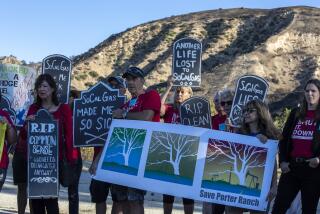Geothermal Experiment Ends; Utility Blames Contract Dispute
- Share via
SAN DIEGO — San Diego Gas & Electric said Tuesday it will shut down a $188.5-million geothermal power demonstration plant in the Imperial Valley because two companies had failed to drill wells that supply the hot “brines” that drive the electrical generation plant.
SDG&E; Vice President Gary Cotton said Tuesday that Unocal Corp. and Chevron Geothermal Co. of California have fallen more than two years behind on a contract to complete the wells that extract brines from underground reservoirs in Heber, keeping the utility from operating the plant at projected capacity.
Unless Unocal and Chevron renegotiate lower-cost contracts to compensate for the two-year delay, the project will “run out of money” before drilling is completed, according to Cotton, who added that SDG&E; “cannot continue to run the plant at the high cost at which it is now running.”
Unocal and Chevron earlier drilled six production wells and five reinjection wells. However, a second set of wells was not completed before a May 8 deadline, according to SDG&E; project manager Bob Lacy. As a result, the plant is operating at about half the 45-megawatt capacity for which it was designed, utility officials said.
SDG&E; decided to shut down the demonstration plant earlier this month after Unocal and Chevron pushed back their drilling schedule until mid-1989, Lacy said. Unocal and Chevron own the geothermal lease holdings at the Heber site.
A spokesman for Chevron, which is directing the drilling program, denied that the two companies have fallen behind schedule.
“We have encountered some delays, but we’re still planning on meeting our contractual requirements,” Chevron spokesman Les Darling said.
SDG&E; recently closed the Heber plant for routine maintenance, but it will not be started up again later this month as planned, Lacy said. Instead, the unique demonstration plant will be closed for an “indefinite” period until “an agreement is worked out” with Unocal and Chevron, Cotton said.
Any costs generated by the plant closing will be absorbed by ratepayers, unless state regulators force SDG&E;’s shareholders to absorb losses, a state Public Utilities Commission spokesman said.
The Heber plant demonstrates the so-called binary process, which extracts relatively hot brines (300-500 degrees Fahrenheit) from beneath the earth’s surface. Those brines heat a second fluid, which powers a turbine that produces electricity. Spent brines are reinjected into the geothermal reservoirs.
Observers of the utility industry have describe the plant as a technical success. However, like many alternative energy plants, it has not proved to be economically feasible because of today’s relatively low fuel oil and natural gas prices.
SDG&E; earlier this month acknowledged that it cannot economically operate the plant at today’s oil prices.
SDG&E; has spent $60 million in ratepayer funds to build and operate the plant. The utility’s 10 partners--including the state, the U.S. Department of Energy, Southern California Edison, Pacific Gas & Electric and the Electric Power Research Institute--contributed the remaining funding.
The PUC has permitted SDG&E; to spend $94 million in ratepayer funds to build and operate the plant. SDG&E; would exceed that spending cap if drilling is not completed until mid-1989, Lacy said.
The utility, which needs regulatory approval to spend money on the plant, lacks the money to cover an estimated $25-million shortfall that the delays will generate, Lacy said.
SDG&E; said it hopes that the companies will provide brine at a lower cost. But if talks fail, Lacy added, the plant will be mothballed.
“SDG&E; management may have decided that it’s time to look where they stand today, as far as costs go,” a PUC spokesman said. “The utility is representing the ratepayers (at Heber), and they may be wondering just how far they can keep going.”
SDG&E; has not yet told the PUC that the demonstration plant will be shut down. However, the PUC could order SDG&E; shareholders to absorb construction and operating costs if commissioners determine that utility managers did not follow “reasonable” construction policies.
If the plant were to be mothballed, geothermal researchers would lose precious data on the plant’s efficiency, according to Basel Roberts, a geothermal expert with the Palo Alto-based Electric Power Research Institute.
“If we stop now, we’ll only get about 30% of what we set out to (learn),” Roberts said.
More to Read
Inside the business of entertainment
The Wide Shot brings you news, analysis and insights on everything from streaming wars to production — and what it all means for the future.
You may occasionally receive promotional content from the Los Angeles Times.










